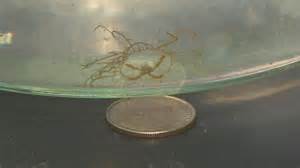CLINGING JELLYFISH
WHAT IS IT?
The Clinging Jellyfish (Gonionemus vertens) is a small jellyfish about the size of a dime that can be found in bay waters.
WHERE ARE THEY FOUND?
Clinging Jellyfish are native to the Pacific Ocean. They were introduced to the eastern Atlantic Coast as early as 1894 in Woods Hole, Massachusetts, but can be found from Maine to North Carolina. They are found in shallow bay waters and cling to vegetation, such as eel grass, during the day. They typically feed at night in the water column on small marine animals (zooplankton). They are not typically found in ocean coastal waters.
HOW BIG DO THEY GET?
This is a small jellyfish that only grows to about 25 mm (1 inch) in diameter, but it can expand to about three inches in diameter. They have 60-80 tentacles that contain the nematocysts or stinging cells.
WHY ARE THEY IN NEW JERSEY WATERS THIS YEAR?
They have been found from time to time in New Jersey waters, primarily in bays. They do not produce large populations as some other jellyfish, but can be found in local areas in small to moderate numbers.
WHAT CAN WE EXPECT THIS SUMMER?
This jellyfish is considered to be an erratic species, meaning that it is not often densely populated. They are often active during periods of unseasonably warm weather and increased water temperatures. Additionally, clinging jellyfish are not likely to be abundant in areas heavily used by swimmers, but could affect casual waders and people gathering shellfish near eelgrass beds.
WHAT SHOULD I DO IF STUNG?
The sting of the Clinging Jellyfish can produce severe pain and other localized symptoms. According to a 1993 article published in the Russian Journal of Marine Biology, if stung by this jellyfish:
- Avoid further contact with the Clinging Jellyfish and carefully remove remnants of the tentacles from your skin; do not touch them directly with fi or any other part of the skin to avoid secondary stinging, use latex gloves or other protective hand
- First rinse the sting site with fresh water, then rinse with an alcohol Or, use a mixture of sodium bicarbonate and water (1:1) then seek medical treatment.
- If symptoms are severe, seek medical attention
REFERENCES:
Fofonoff PW, Ruiz GM, Steves B, & Carlton JT. 2003. National Exotic Marine and Estuarine Species Information System. invasions.si.edu/nemesis/
Mysterious Jellyfish Makes a Comeback: Rise in toxic stings has scientists on the alert.
www.whoi.edu/page.do?pid=7167&tid=3622&cid=185270#sthash.LEzi7wPa.dpuf
Schuchert, P. (2016). Gonionemus vertens A. Agassiz, 1862. In: Schuchert, P. (2016). World Hydrozoa database. Accessed through: World Register of Marine Species at www.marinespecies.org/aphia.php?p=taxdetails&id=117768 on 2016-06-13WoRMS (World Register of Marine Species) Database. Gonionemus vertens (A. Agassiz, 1862)


